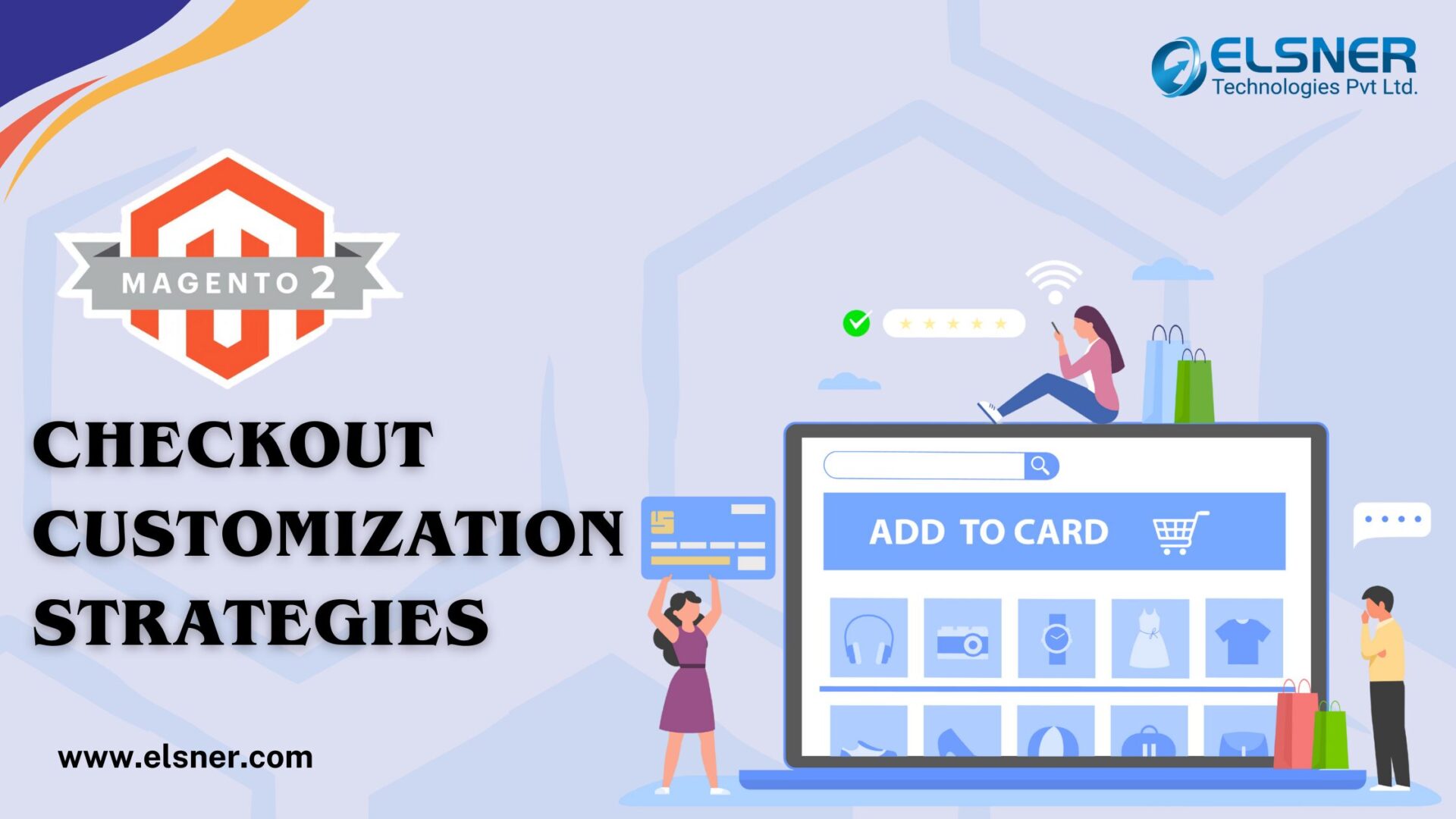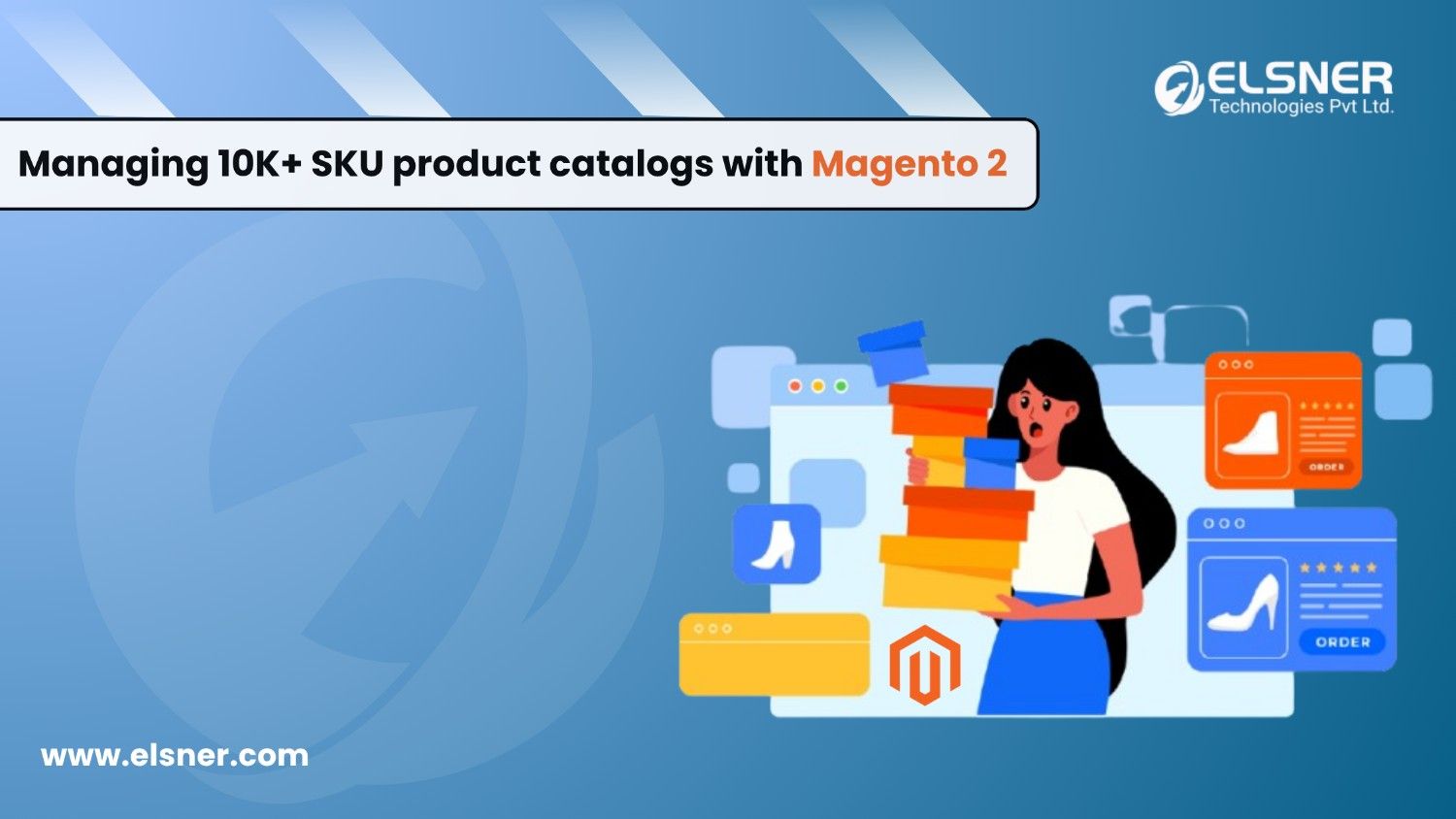- Why Understanding Magento 2 Architecture Matters?
- Magento 2 Core Architectural Principles
- 1. Modularity
- 2. Service-Oriented Architecture (SOA)
- 3. Layered Structure
- 4. Object-Oriented Programming (OOP)
- Exploring Magento 2 Architectural Layers
- 1. Presentation Layer (View)
- 2. Service Layer (API)
- 3. Domain Layer (Business Logic)
- 4. Persistence Layer (Data Access)
- Get Expert Magento 2 Development for Your Store
- Key Components and Their Functions
- 1. Modules
- 2. Themes
- 3. Layouts
- 4. Blocks
- 5. Models & Collections
- 6. Events & Observers
- 7. Plugins (Interceptors)
- The Magento 2 Request Flow
- Optimizing the Request Flow for Performance
- Performance Optimization: Getting the Best Out of Magento 2 Architecture
- 1. Enable Full Page Caching
- 2. Use Varnish Cache
- 3. Optimize Database Queries
- 4. Minimize CSS and JavaScript
- 5. Implement a Content Delivery Network (CDN)
- Real-World Benefits of Understanding Magento 2 Architecture
- In a Nutshell
In the present fiercely competitive Ecommerce world, picking the right platform is like choosing between coffee or sleep — make the wrong call, and your day (or business) is doomed. Magento 2 open source is that strong, dependable cup of coffee that keeps your online store running efficiently, even when things get chaotic. But what makes it so powerful? It’s all in the Magento Ecommerce architecture.
Now, don’t hit snooze just because we said “architecture.” This isn’t a boring blueprint lesson — it’s about understanding how Magento 2’s framework empowers you to build a high-performing Ecommerce store that’s scalable, customizable, and downright impressive. Whether you plan to hire Magento developers or want to geek out about the platform, this guide will break things down in a way that makes sense, maybe even fun. Yes, fun.
Why Understanding Magento 2 Architecture Matters?
Let’s break down why getting cozy with Magento Ecommerce architecture is a smart move:
- Efficient Development: Knowing the Magento 2 structure helps Magento enterprise developers write cleaner code, which means fewer headaches for everyone. When your Magento 2 development services team knows where every code block belongs, troubleshooting becomes as easy as finding pizza at a party. Imagine updating your store’s payment gateway without disturbing the entire checkout process—pure bliss.
- Performance Optimization: Like cutting carbs for speed, using the right Magento Ecommerce architecture improves load times. With Magento 2’s architecture, your site will load faster than a cat pouncing on a laser pointer. Faster load times mean happier customers and higher conversion rates—win-win!
- Strategic Customizations: Tailor your store without ripping out its foundation. Imagine renovating your kitchen without turning your house into a construction zone — that’s what Magento Ecommerce architecture allows. Want to add a loyalty points system? Go ahead, no need to upend your entire store.
- Seamless Problem-Solving: Spot and fix issues faster than your cat finding its way into every box in the house. Thanks to Magento 2’s modular structure, Magento enterprise developers can isolate and resolve problems without breaking a sweat. Say goodbye to “one change breaks everything” scenarios.
Magento 2 is open-source, meaning developers and merchants alike have the freedom to create custom Magento enterprise solutions. By understanding its architecture, you unlock the secret sauce for Ecommerce success.
Magento 2 Core Architectural Principles
Magento 2’s architecture is built on principles that ensure flexibility, performance, and scalability:
1. Modularity
Magento Ecommerce architecture is composed of discrete, interchangeable modules. Think of it as Lego blocks for your store — snap them together or swap them out as needed. This flexibility is why Magento enterprise development companies love the platform.
Example: Imagine wanting to add a “gift wrapping” feature to your store. Instead of rebuilding your entire checkout process, just plug in a module for gift wrapping. Simple and efficient.
| Benefits of Modularity | Description |
| Easy Updates | Update specific parts without affecting others |
| Customization | Add features as needed |
| Better Maintenance | Simplified debugging and enhancements |
2. Service-Oriented Architecture (SOA)
The SOA approach allows different services to communicate seamlessly through APIs. It’s like getting your smart home devices to play nice. Your payment gateway, shipping provider, and magento 2 inventory system can work together without chaos.
Example: Want to connect your Magento store to a third-party CRM system? SOA makes it a breeze.
3. Layered Structure
Each layer in Magento 2 open source serves a distinct purpose, from data handling to business logic and presentation. This layered approach keeps things neat and manageable.
| Layer | Function |
| Data | Handles data operations |
| Business | Processes store logic |
| View | Manages UI presentation |
Example: When a customer places an order, the data layer retrieves product details, the business layer processes payment and inventory updates, and the view layer displays the confirmation page.
4. Object-Oriented Programming (OOP)
Using OOP principles, Magento 2 ensures that code is reusable, maintainable, and scalable. It’s coding with common sense — kind of like buying a universal remote instead of one for each device.
Example: Need to create a custom discount logic? With OOP, you can extend existing classes rather than starting from scratch.
Did you know? Magento 2’s OOP-based architecture reduces code duplication.
Exploring Magento 2 Architectural Layers
To truly understand Magento 2, it’s essential to explore its key architectural layers:
1. Presentation Layer (View)
This layer handles everything related to the user interface, including themes, layouts, and templates. It’s where you make your store look like a million bucks. Want a slick design? Hire Magento experts to work their magic here.
Example: You can create a holiday-themed storefront without altering the core functionality of your store. The flexibility provided by the Magento 2 framework ensures that visual enhancements remain separate from business logic.
Pro Tip: A Magento development company can help you implement dynamic themes for seasonal promotions.
2. Service Layer (API)
The service layer facilitates communication between different system components and external services. This is where REST and GraphQL APIs come into play, allowing seamless integrations.
Example: Integrate your Magento store with a shipping provider to automatically fetch delivery rates. Efficient API communication within the Magento 2 structure ensures faster and more reliable connections.
Stat: Ecommerce businesses that optimize API communications experience up to a 15% improvement in checkout speed.
3. Domain Layer (Business Logic)
The domain layer manages business operations, processing orders, and handling product data. It’s the decision-maker of your store, making sure customers get the right product at the right price.
Example: Want to offer a “buy one, get one free” deal? The domain layer handles that logic seamlessly. Magento 2 development services can help you implement complex promotional rules to enhance customer engagement.
4. Persistence Layer (Data Access)
This layer interacts with the database, managing data retrieval and storage. It’s the brain behind the scenes, ensuring your store remembers customer preferences and order histories.
Example: When a customer logs in, this layer retrieves their order history and preferences, enhancing the user experience. A well-configured persistence layer ensures faster database operations, which is crucial for Magento enterprise solutions.
| Layer | Function |
| Presentation | Handles user interface |
| Service | Manages API communications |
| Domain | Processes business operations |
| Persistence | Manages database interactions |
Understanding the Magento 2 Ecommerce architecture and its layered approach enables businesses to create scalable and efficient online stores. Whether you are looking to hire Magento 2 developers or partner with a Magento development agency, grasping these layers ensures smoother project execution.
Get Expert Magento 2 Development for Your Store
We build high-performance Magento 2 solutions tailored to your unique business needs.
Key Components and Their Functions
Magento 2 architecture comprises several critical components:
1. Modules
Modules encapsulate specific functionalities. Think of payment gateways, checkout processes, or customer management. A Magento development agency can help you configure and optimize these modules.
Example: Enable a “quick checkout” module to improve user experience.
2. Themes
Themes control the visual aspects of your store, from colors and typography to layouts. First impressions matter, and a good theme can make your store unforgettable.
Example: A sleek, minimalist theme can make your luxury products stand out.
3. Layouts
Layouts define the structure of a page, specifying which blocks appear and where. Think of it as the blueprint for your storefront.
4. Blocks
Blocks are PHP classes that connect layout elements with data from the database. They ensure your content shows up where it’s supposed to.
5. Models & Collections
Models represent business logic, while collections handle groups of models. Together, they keep your store’s data flowing smoothly.
6. Events & Observers
Events allow developers to hook into specific actions, while observers respond to these events. Think of it as your store’s “If this, then that” system.
Example: Send a thank-you email when an order is placed.
7. Plugins (Interceptors)
Plugins modify the behavior of existing methods without changing the core code. Sneaky, but in a good way.
Example: Apply a custom discount rule without altering the checkout process.
| Component | Function |
| Modules | Add specific store functionalities |
| Themes | Control visual aspects |
| Layouts | Define page structure |
| Blocks | Connect UI elements with data |
| Models | Represent business logic |
| Collections | Manage groups of models |
| Events | Hook into specific store actions |
| Plugins | Modify behavior without core code changes |
The Magento 2 Request Flow
Understanding the request flow helps you see how Magento 2 open source processes user interactions:
- Request Initiation: A user makes a request (like visiting a product page). Imagine someone walking into a store and pointing at a product. Magento 2 takes that request seriously.
- Front Controller: The front controller plays the role of the store manager, directing the user’s request to the right department.
- Routing: Think of routing as the GPS of Magento 2 Ecommerce architecture. It ensures the request gets to the right controller, kind of like guiding your customer to the aisle with their favorite snacks.
- Example: When a customer searches for “Men’s Running Shoes,” routing directs the request to the right category page. Well-optimized routing can reduce server response time.
- Controller Action: The controller is where the real action happens. It processes the request, interacts with the appropriate layers, and prepares the response. Think of it as the chef in a restaurant — taking the order, cooking it up, and plating it just right.
- Pro Tip: Hire Magento developers to create custom controller actions for unique store functionalities.
- View Rendering: The view layer is like the presentation of your dish — beautifully plated and ready to serve. This layer generates the HTML that customers see.
- Example: You can customize your storefront view to showcase product recommendations based on browsing history.
- Response Delivery: The final HTML is sent to the user’s browser faster than express delivery pizza. The customer sees their requested page, hopefully impressed by the speed and design.
| Request Stage | Function |
| Request Initiation | The user requests a page |
| Front Controller | Directs requests to the right component |
| Routing | Guides request to the appropriate controller |
| Controller Action | Processes the request |
| View Rendering | Generates HTML response |
| Response Delivery | Sends HTML to the browser |
Optimizing the Request Flow for Performance
Want lightning-fast response times? Consider these tips:
- Caching: Use Varnish and Full Page Caching to serve responses quickly.
- Code Optimization: Ensure your Magento 2 development services team writes efficient code.
- Load Balancing: Distribute requests evenly across servers to handle high traffic volumes.
Did you know? Stores optimized for request flow see considerable increase in customer engagement rates.
By understanding Magento 2’s request flow, businesses can create smoother user experiences, faster page loads, and ultimately, higher conversion rates. Whether you’re seeking Magento enterprise development or planning to hire Magento experts, knowing this architecture makes all the difference.
Performance Optimization: Getting the Best Out of Magento 2 Architecture
When it comes to Ecommerce, slow websites are like long lines at coffee shops—frustrating enough to send customers running. Fortunately, Magento 2 architecture offers powerful tools and techniques to ensure your store runs faster than a cat chasing a laser pointer. Let’s break down some effective strategies to optimize performance.
1. Enable Full Page Caching
Imagine serving freshly brewed coffee instead of making each cup from scratch—that’s full-page caching for your website. By storing pre-rendered pages, Magento 2 reduces server load and speeds up page load times, giving your customers a snappy browsing experience.
2. Use Varnish Cache
Varnish Cache works like that ultra-efficient barista who knows your order before you say a word. It accelerates content delivery by caching frequently requested pages and reducing server response time.
Pro Tip: Many Magento development companies recommend integrating Varnish with Magento 2 framework to boost site speed.
3. Optimize Database Queries
Efficient database queries are like well-organized inventory shelves—everything is easy to find and fast to retrieve. Cleaning up redundant queries can significantly reduce response times, making your Magento Ecommerce architecture hum like a well-tuned engine.
Stat: Optimized database queries can improve Ecommerce site performance by up to 20%.
4. Minimize CSS and JavaScript
Think of CSS and JavaScript as the clutter in your workspace—less is more. Minifying these frontend assets reduces their size and speeds up loading times, creating a cleaner and faster user experience.
5. Implement a Content Delivery Network (CDN)
A CDN is like having warehouses across the globe, ensuring faster delivery of your assets. By serving content from the closest server to your customer, you reduce latency and improve site performance.
Example: Ecommerce stores using CDNs often experience up to a 50% reduction in page load times.
| Optimization Strategy | Benefit |
| Full Page Caching | Faster load times, reduced server load |
| Varnish Cache | Accelerated content delivery |
| Optimized Queries | Improved database performance |
| Minified CSS & JS | Faster frontend rendering |
| CDN Implementation | Reduced latency, global content delivery |
Not only do these performance optimization techniques enhance user experience, but they also positively impact search engine rankings—Google loves fast-loading sites. Whether you hire Magento developers or work with a Magento development agency, optimizing your store’s performance should be a top priority. Remember, a faster site means happier customers and better conversions.
If you’re exploring Magento 2 development services or looking to hire Magento 2 developers, understanding these optimization strategies ensures you’re making informed decisions. After all, a high-performing store is a successful store.
Real-World Benefits of Understanding Magento 2 Architecture
When you grasp Magento’s architecture, you unlock several benefits:
- Better Customization: Create tailored solutions that align with your business needs.
- Enhanced Performance: Optimize your store for lightning-fast speed.
- Scalability: Easily expand your store as your business grows.
- Cost Efficiency: Reduce development and maintenance costs.
Businesses across the USA are increasingly hiring Magento developers to leverage these advantages.
In a Nutshell
Understanding Magento 2 architecture isn’t just for tech enthusiasts — it’s for anyone serious about Ecommerce success. By familiarizing yourself with its modular structure, service-oriented architecture, and layered approach, you can unlock unprecedented flexibility and performance.
Whether you are looking to hire Magento 2 developers or simply want to make smarter business decisions, this knowledge will empower you. Keep exploring, learning, and innovating — because Magento’s architecture is the foundation of Ecommerce success. And hey, now you can impress your tech-savvy friends at the next dinner party too.

About Author
Dipak Patil - Delivery Head & Partner Manager
Dipak is known for his ability to seamlessly manage and deliver top-notch projects. With a strong emphasis on quality and customer satisfaction, he has built a reputation for fostering strong client relationships. His leadership and dedication have been instrumental in guiding teams towards success, ensuring timely and effective delivery of services.




